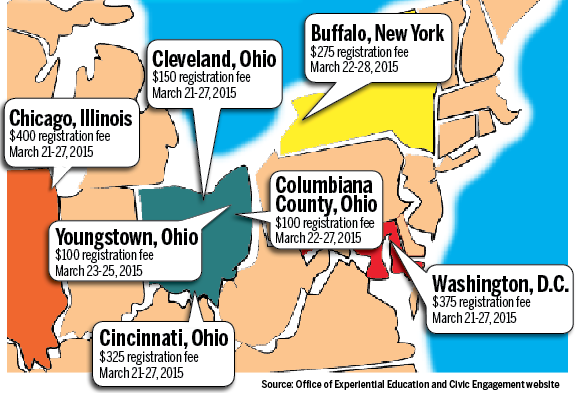Spring break decision: Work or play?

Graphic by Kelly Travillian
February 11, 2015
Spring break can be described as one week of sacred relaxation. Whether individuals binge-watch Netflix or disregard sunscreen in hopes for a deep tan, students have their choice of what they will indulge in.
However, roughly 125 students choose to participate in the Alternative Spring Break program each year, according to the Office of Experimental Education and Civic Engagement.
Alternative Spring Break is a chance for students to work outside of their comfort zones. Students interact with diverse cultures and partake in assistance programs directed toward those in need. The Alternative Spring Break program at Kent goes on seven different trips, ranging from Buffalo, New York, to Washington, D.C.
Alternative Spring Break Trips
-
Buffalo, New York
$275 registration fee
March 22-28, 2015
-
Chicago, Illinois
$400 registration fee
March 21-27, 2015
-
Columbiana County, Ohio
$100 registration fee
March 22-27, 2015
-
Cleveland, Ohio
$150 registration fee
March 21-27, 2015
-
Washington, DC
$375 registration fee
March 21-27, 2015
-
Youngstown, Ohio
$100 registration fee
March 23-25, 2015
-
Cincinnati, Ohio
$325 registration fee
March 21-27, 2015
Source: Office of Experiential Education and Civic Engagement website
On the trips, students participate in volunteer work that ranges from engaging with Native American culture and helping communities to learning about the environmental and social issues of fracking.
Cody Waterman, facilitator of the Buffalo trip, worked as a “behind-the-scenes” helper and a financial guide. Last year, Waterman’s group worked to put up the drywall in a Habitat for Humanity home.
“When we walked in, it was all beams. We put all the drywall on the ceiling and the walls,” Waterman said. “It made us feel so accomplished… When we left it actually started to look like a house which was really cool.”
Taking time to understand the difference students were making, Waterman described the most important part of the trip as their nightly reflection.
“We’d get together and reflect on what we did, how we felt about it, and the impact it had on the community and ourselves,” Waterman said.
Working with Habitat for Humanity is just one example of the work students will do on the trip. Interim Director of Experiential Education Anna Gosky oversees the implementation of the different programs and learning experiences — and for her, learning about the work done for homeless rights at the local, state and national level is most powerful.
“They are amazing stories of hope, persistence and struggle,” Gosky said.
Students participating in Alternative Spring Break are said to develop drastically over the few days spent volunteering. Waterman said working to create positive change in the different settings creates lasting friendships and unlikely bonds.
It is also a mental and spiritual growth, Waterman said.
“It truly is immersing yourself into something that’s greater than just you. You’re taking part in something that has an effect on lives, and you may not even realize it,” Waterman said.
He described the alternative spring-breaker as “open, willing to be vulnerable, and willing to be challenged.”
The groups contributing to the Alternative Spring Break trips make a difference beyond themselves. For Gosky, her main goal is for students to simply leave the trip questioning their own privilege and social issues.
“The students who attend the trips are the nation’s future… the individuals who will create positive change in their own communities, in our country and around the globe,” Gosky said.
Sign-ups for the Alternative Spring Break trips can be found online. For more information, contact Ann Gosky.
Contact Payton Moore at [email protected].
























